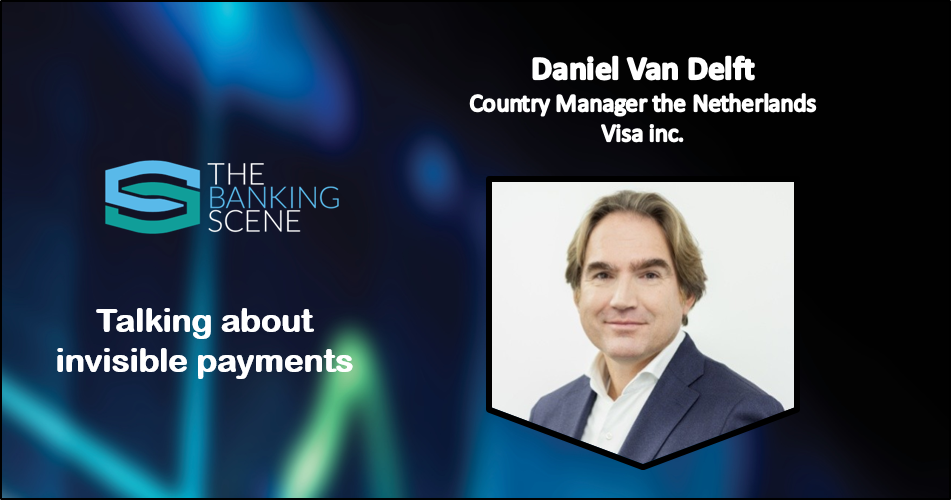
Insights & Opinions
Talking about invisible payments with Visa
Tue, 13 Aug 2019

In the first interview, you could read how Visa looks at Open Banking. In the same session, I also took the opportunity to continue the discussion on one of my personal favorites: invisible payments. Everyone talks about invisible payments and its advantages: “It is seamless and that is what consumers like”. The other angle, according to me, that is often forgotten is the risk for consumers.

In the past, everyone was limited in its consumption to what was in their pocket. Today they have in that same pocket the key to a lot more money on their account, and beyond through all kinds of digital payment means. Should the industry also be playing a role here, beyond payments?
That is clearly also one of our own key interests. We want to make sure that the customer has that control in the future, even in the world of invisible payments. It is not a coincidence that we developed the Visa Transaction Controls API, to really make sure that consumers are in control of their credentials and are notified of all payments they make.
That is part of an evolution to be conscious of your consumption, also in an increasingly digitized world.
Altogether, we are an enabler, but in this case, we play an important role. We need to provide all stakeholders with the right tools, provide consumers with the right instruments in their pockets, and in mobile wallets, like in the Uber app.
In Uber, you have a kind of invisible payment already, but it is not really invisible: you still go to your Uber app, you confirm the indicated price is OK and you get in the taxi.
I guess the impulsive consumption poses more risks. When using Uber, it is a conscious decision. It is not an impulsive purchase normally. It is different on for example gambling websites. There is still a conscious decision, but often ‘against the will’ of consumers, more out of addiction. Starling is a good example: they developed a button that prevents consumers from gambling for 48 hours, without the possibility to activate it again within this timeframe.
That is exactly what we are working on. For example in the domain of parental controls, either in gaming or in-game purchases, we are very keen to provide parents the right control mechanisms to make sure the payments that are made are really conscious payments.
These are often impulse-driven payments, making parental controls of high importance. We are working on this innovation.
Very interesting is the use case of asylum centers in the Netherlands for example. These people are only allowed to buy food, groceries, and no possibility to gamble with the provided money for example.
Where it makes sense and where it benefits society, we are very collaborative to investigate how these Visa Transaction Controls are useful to restrict usage of a certain payment type, permanently or temporarily. Also, geographic restrictions are possible — with a function called country controls. All type of blockings is already possible today.
The Visa Transaction Controls are APIs in our Visa developer platform, which we open for developers, where we put our best products into APIs so banks don’t have to develop everything themselves. They can now take an API from the shelf and build it in their mobile banking app.
We have about 140 APIs globally available live today. Around 30 banks in Europe have been already working on projects within the Visa developer platform.
I guess that is where digital becomes an opportunity in the world of invisible payments, as a means to get more control.
Exactly, when you think of mobile payments, we have so much overview of every payment, every merchant. Take the Uber experience, or the Grab experience, the Lyft experience, or whatever… they know more upfront than when you would be paying a regular taxi.
The digital version allows you to see what car you have, who is driving you, how much the payment will approximately be, what the license plate is… That was not the case in the past, so today you can make decisions in a better-informed way, but with the payment being invisible, hidden at the back.
Of course, there are a lot of market places and they all have to find their own value yet, but that is up to these market places. We, Visa, are the enabler for the payments’ side. Together with our client parties, we try to make it as seamless as possible, but still with an active conscious decision process for the customer.
Am I getting it right that to make this possible you provide issuers the right tools to facilitate this conscious decision for their customers, as service?
Indeed, we position ourselves more and more in that direction, also in partnership. The APIs help us a lot with that.
If we and the partner believe a certain service has value, for the ecosystem, then we bring them in our API set of offerings, so our clients can simply consume it. It is a continuous effort to make this API consumption as easy as possible to allow seamless integration by our partners.
Of course, the integration does not only depend on us but also on our clients. We also see that Open Banking is paving the way for easier consumption and management of APIs at the issuer side.
Now coming back to invisible payments, of course, we are already thinking about tomorrow’s payments. We started thinking of how consumers can be made aware in the world of voice commerce: how does someone know that he/she made a Visa transaction on Alexa? That is when we developed the Visa sound. We just recently announced that our sensory branding suite was adapted in 25 countries via more than a dozen new partnerships.
The suite is comprised of sound, animation and haptic brand cues that occur with a Visa payment transaction and is aimed to convey the trust and security that the Visa brand represents. It will take a while before this kind of innovation becomes the norm, but it is around us already, and it will be big in the future. Voice commerce will be another variety where we see the future going.
Also in wearables, such as Fitbit, we must make sure the consumer trusts it. That is where the Visa brand is very important. They must know it is minimum as secure as a card payment.
We can only link the brand Visa to new payment types when it is 100% trusted and secure. We are not only pushing for security, but it is a base layer before you can move into a partnership with us.
Talking about Voice commerce in cards for example: ordering a pizza through voice commands is getting really close now.
We did research on 2000 consumers with The Banking Scene, where we also surveyed whether they were willing to have their payments done by their car or their fridge. In the Netherlands, about 27% would trust it, on the condition that they can get a notification or a final validation of the payments.
The end validation is an important part: we provide the controls so at the end you as a consumer can decide to pay or not. That is what we, like Visa, really have to ensure in that customer survey. It is not so much a matter of regulation but really a customer expectation.
In the end, it all comes down to customer adoption. Sometimes it may require some education, like with contactless, but it is key to making innovation successful and to be able to scale. And we are in a business of scale.